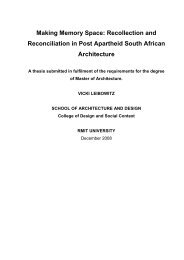Objects in Flux - RMIT Research Repository - RMIT University
Objects in Flux - RMIT Research Repository - RMIT University
Objects in Flux - RMIT Research Repository - RMIT University
You also want an ePaper? Increase the reach of your titles
YUMPU automatically turns print PDFs into web optimized ePapers that Google loves.
5.<br />
Tell<strong>in</strong>g Stories<br />
Cyl<strong>in</strong>dric ultrasonic bat detector<br />
Published Sunday, 10 April, 2005<br />
http://www.openobject.org/objects<strong>in</strong>flux/?p=16<br />
African heart-nosed bats can hear the footsteps of a beetle<br />
walk<strong>in</strong>g on sand from a distance of more than six feet.<br />
[Amaz<strong>in</strong>g Bat Trivia] 1<br />
That’s really got noth<strong>in</strong>g to do with echolocation (the sonar<br />
system used by bats) or the device I’m about to describe, but<br />
it’s a pretty stunn<strong>in</strong>g piece of trivia.<br />
Bats are fasc<strong>in</strong>at<strong>in</strong>g creatures and here <strong>in</strong> Melbourne they<br />
are a common sight. At dusk streams of grey-headed fly<strong>in</strong>g<br />
foxes leave their camp <strong>in</strong> the Royal Botanical Gardens to<br />
plunder fruit and nectar from suburban flower<strong>in</strong>g gums. The<br />
number of urban bats has swelled <strong>in</strong> recent years, giv<strong>in</strong>g the<br />
impression that the grey-headed fly<strong>in</strong>g fox is thriv<strong>in</strong>g, but<br />
<strong>in</strong> reality Australia’s bat population has decreased by 30%<br />
over the past decade. The <strong>in</strong>crease <strong>in</strong> urban bat colonies is<br />
the result of ongo<strong>in</strong>g destruction to the bats’ native feed<strong>in</strong>g<br />
grounds. The Melbourne Royal Botanical Gardens is<br />
now the only breed<strong>in</strong>g colony of grey-headed fly<strong>in</strong>g foxes<br />
1/ Amaz<strong>in</strong>g Bat Trivia, http://www.batcon.org/discover/<br />
trivia.html accessed 20 July 2006.<br />
5.1 Introduction<br />
The chapter presents two parrallel naratives.<br />
The central body of the page is given over to<br />
stories developed through the modification<br />
practice while the academic text is relegated to<br />
the marg<strong>in</strong>s. The stories written while engaged<br />
<strong>in</strong> acts of object modification take the form of<br />
personal narratives that document various proj-<br />
ects carried out dur<strong>in</strong>g the PhD research. i As re-<br />
search documentation, these narratives do not<br />
claim an objective, elevated position. But rather,<br />
they construct partial knowledges from with<strong>in</strong><br />
the practice (Law, 2000). Initially published on<br />
my research blog, the texts mirror established<br />
forms of user-generated content and actively<br />
engage a diverse community of amateur prac-<br />
titioners. Re-presented here, the texts act as<br />
i. For a complete collection of research<br />
narratives refer to the research blog <strong>Objects</strong> <strong>in</strong><br />
<strong>Flux</strong>, http://www.openobject.org/objects<strong>in</strong>flux.<br />
[Figure 5-1 – fac<strong>in</strong>g page]<br />
Search<strong>in</strong>g for bats with the Cyl<strong>in</strong>dric Ultrasonic<br />
Bat Detector, Melbourne, Australia, 2004.<br />
79
















